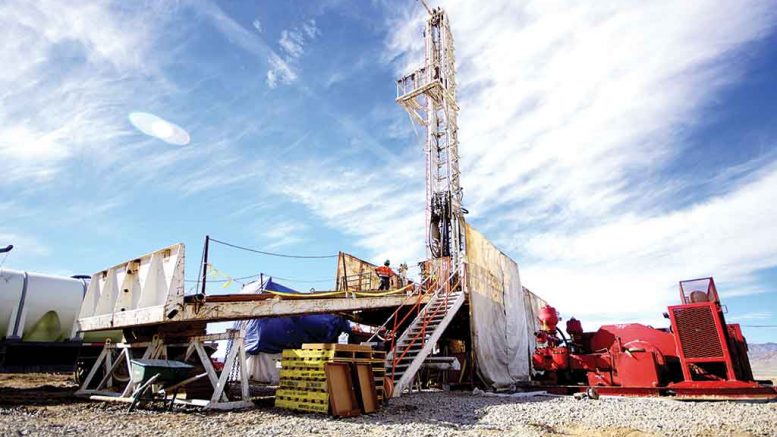VANCOUVER — Pure Energy Minerals (TSXV: PE; US-OTC: PEMIF) hopes to start construction on a lithium hydroxide operation at its Clayton Valley project in Nevada by 2019. On June 26, the company released a preliminary economic assessment (PEA) that lays out its path to production, which hinges on a US$10-million pilot plant that could be operation by the end of 2018.
Clayton Valley lies halfway between Las Vegas and Reno in Esmeralda County. The 105 sq. km project hosts lithium brines within unconsolidated sediments (gravel, sand, etc.) that infill a basin beneath the claim area. Pure Energy found lithium-bearing brines 130 to 600 metres underground.
The study forecasts average annual production of 10,300 tonnes of lithium hydroxide — or 9,100 tonnes lithium carbonate equivalent (LCE) — over a 20-year mine life. The mine plan is underpinned by an updated “drainable mineral resource,” which includes 218,000 tonnes of LCE in the inferred category.

The 105-sq.-km project hosts lithium brines within unconsolidated sediments that infill a deep basin beneath the claim area. Credit: Pure Energy Minerals.
“The geology has been the biggest curveball for us. It’s a structurally complex basin that has multiple stages of deformation. It was ripped apart at the same time it was formed,” CEO Patrick Highsmith says during a phone interview.
“Our resource has gotten smaller. Most comparable basins tend to be pretty homogenous, but in Clayton Valley that’s not entirely true. There is exploration potential in the south, but at this time we’ve opted to be conservative and draw a hard line. We’ve offset that with higher grades and a deeper resource,” he adds.
The company released a resource update in mid-2015 that estimated Clayton Valley contained 816,000 inferred tonnes of LCE. In the new resource estimate, an area in the south was excluded owing to negative drill results.
Pure Energy is working with Tenova Advanced Technologies (TAT) and GE Water and Process Technologies to develop a proprietary lithium flow sheet that could improve recoveries and lower water use. Based on “mini pilot-plant” testing, the process achieves lithium recoveries over 91%, which is higher than traditional evaporation ponds.
Proof-of-concept plant test work was finished in 2016 at TAT’s Research and Development Center in Israel.
The operation would cost US$300 million in upfront capital to build, and feature a 21% after-tax internal rate of return and US$264-million net present value at an 8% discount rate. The project payback period is estimated at four years.

Drill rigs testing for lithium brines at the Clayton Valley project in Nevada. Credit: Pure Energy Minerals.
The base case in Pure Energy’s study forecasts a lithium hydroxide price of US$12,000 per tonne in 2021 — when the proposed Clayton Valley project would ramp up. The price is modelled to strengthen through 2025 to US$16,500 per tonne.
“We opted for a smaller, initial design proposal. When you look at the lithium space you see companies declaring these huge megaprojects,” Highsmith says.
“Mine plans can take years to ramp up, and might be a little too ambitious. We’re just fine with our design because we see high-margin potential from the new technology, and the investment returns are downright attractive. Our flow sheet indicates we’ll make battery-grade hydroxide right in Nevada, and that’s a rare thing,” he says.
Pure Energy says it will need US$18 million to move Clayton Valley through feasibility, which includes US$10 million earmarked for the new pilot plant in Nevada.

Views of western Nevada near the Clayton Valley project in Esmeralda County. Credit: Pure Energy Minerals.
The test facility would run continuously for six months. Highsmith says the process will “answer a lot of engineering questions” and help the company commercialize and scale its processing technology. The company aims to start pilot testing in late 2018.
Meanwhile, Pure Energy will follow up on exploration potential.
It is budgeting for more geophysical surveys across Clayton Valley’s broader property package, and announced in May that it had acquired another 60 sq. km in the region from Frank Giustra’s Lithium X (TSXV: LIX; US-OTC: LIXXF). Pure Energy will pay 20 million shares and 2 million warrants for the 756 unpatented mineral claims.

A worker unloads drill core at Pure Energy Minerals’ Clayton Valley lithium project in Nevada. Credit: Pure Energy Minerals.
“It’s a bit easier in terms of expansion than a traditional mine because we’re talking about the well field,” Highsmith says. “We’ll look at the exploration and expansion potential in tandem with our feasibility work. We’ve allowed six quarters for the basin drilling work, so it will be continuous as we advance. The Lithium X acquisition was nicely timed and our team says there’s brine on those claims.”
Lithium X also completed a $2-million investment in Pure Energy wherein it bought 3.6 million units at 56¢ apiece, with each unit comprised of a share and half a warrant exercisable at 75¢ for three years.
As for permitting, Clayton Valley’s hydrographic basin was designated “in need of additional administration” by the Nevada state engineer in early 2016.
The company will have to obtain its water rights for the pilot plant, and eventual production.
In addition, Pure Energy will have to navigate water concerns raised by chemical producer Albemarle (NYSE: ALB), which operates the Silver Peak lithium mine nearby.
“When you bring a project like Clayton Valley to the feasibility stage, you tend to see investors emerge who want direct involvement in the project,” Highsmith says. “This is the time to go out and build those relationships. We don’t believe the feasibility study will need to be funded fully by equity … other parties will want to join. Maybe they want to get a lithium contract in place, or become a partner.”
Pure Energy has traded in a 52-week range of 49¢ to 97¢, and closed at 51¢ per share at press time. The company has 66 million shares outstanding for a $34-million market capitalization.






Be the first to comment on "Pure Energy unveils PEA for Clayton Valley lithium"